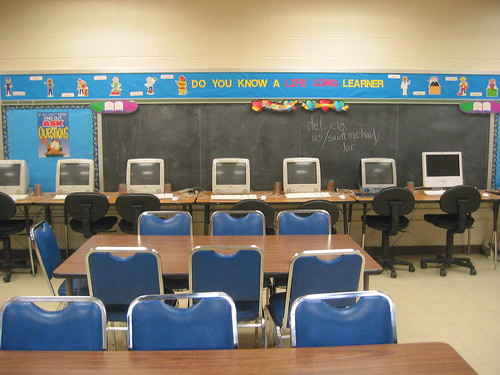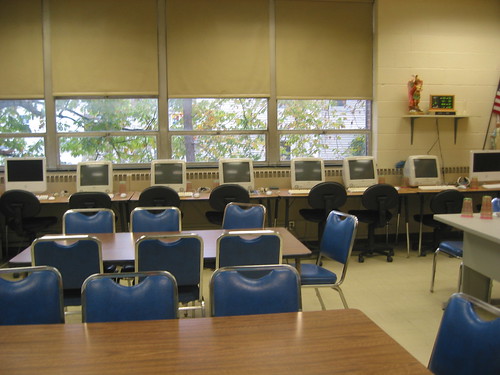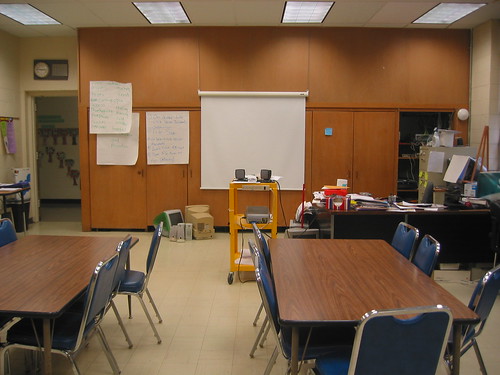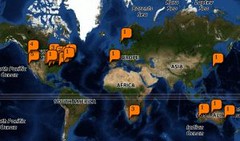When I read Mark's Edtechblog just now, I decided to add my two cents. The Random Thoughts of Louis Schmier is a blog that I look forward to reading. I don't know how I came across his blog, but there it was one day. Louis Schmier is a college professor. He has such heart for his fellow students and shares it so eloquently.
One post back in early September spoke about a message "Clean" that he had been receiving for a whole week in his email inbox. After explaining the message, he finishes up the post by posing the question, "What is one thing you said or did today that made another person felt more special and appreciated?" He always makes me think.
If you've never made a stop at his blog, let me suggest you do so today. I'm always inspired and hope he's around for a very long time. I've already sent in my vote for him in the Best New Edublog category 2007. While I receive a lot of takeaways from Dy/Dan and get many chuckles from The Principal's Page.com Blog, my heart is always full after reading Louis Schmier.
Thursday, November 29, 2007
Sunday, November 25, 2007
If Wishes Were Horses...

There is a nursery rhyme: If wishes were horses, then beggars would ride; if turnips were watches, I'd wear one by my side. It feels that way when I work on the personal development side of the report card.
We used to give one personal development grade for each student. This year, each subject area teacher will give twelve marks to each student. The list is as follows:
- Works to ability
- Completes classwork
- Completes homework
- Follows directions
- Works well in groups
- Works well independently
- Respects the rights and property of others
- Demonstrates self-discipline
- Obeys school rules
- Shows a sense of responsibility
- Uses time constructively
- Exhibits positive attitude/ behavior
To help me keep track of everyone, I put together a Personal Responsibility Report. If they have a lapse in responsibility (a uniform untucked, nail polish, forgotten homework, missing signed quiz/ test, notebook forgotten) they fill out the form. It tells me who, what, when, and why something is awry. In my mind, it forces the student to be more responsible than just saying "I forgot".
If wishes were perfect responsibility, I wouldn't have to take time to go through so many forms. It has taken a good few hours and I'm almost done, but I'm seeing some holes. Next semester, I have to be more on top of some of the categories. I have good data tracking what they bring to class, but I need better data on how far they get with practice problems in class and when they drift from their independent work. I want less anecdotal evidence from my head and something more concrete on paper. I want to reward students who don't forget a single thing. Still, I don't want to drop a child from outstanding to satisfactory for forgetting something just one time.
Then there is the improvement needed and unsatisfactory categories. I wish every student did almost every assignment. I really only have a handful of students that need more phone calls home. I'm going to have to focus on those few children.
So, all in all, it's a good exercise to have to go through for each child...but I wish for the perfect world.
Image Citation:
"200602 watch your step.” supercilliousness' Photostream. 18 Feb 2006. 25 Nov 2007. http://farm1.static.flickr.com/30/101377264_dc5d1e9449.jpg
Saturday, November 24, 2007
Prepping for Sub

One of the least favorite aspects of my job is prepping for a sub. This year, Friday is a really tough day for me. So I pretty much decided in advance that I would not purposely take off on a Friday all year.
Well, I've purposely taken off on Friday this week to attend the Education 2.0 conference at Kean College down the road.
I have sixteen desktops and six laptops. Friday is my day of juggling. Sixth grade computers twice in a row. I just finished a big PowerPoint project with them, so I need to get them going on a project this Wednesday that they will be able to work on Friday.
At the end of the sixth grade periods, I set up the laptops for the fourth then third graders. I think the easiest thing to do will be to have them work on a writing project in Word. It's the last day of the marking period, so maybe a document telling me all the most important things we learned to date.
Next the lucky sub has a lunch period, then on to two periods of sixth grade math. The students have just completed the multiplication unit and are beginning the division unit, but I think I will have them get a start on the Chapter Closure problem. They can work alone for 15 minutes, in groups for 15 minutes, then get started on their write up.
Fifth grade computer class should actually be pretty straight forward. They are finishing up a KidPix welcome drawing for our Classroombraids project. Afterwards, I think I will have 15 images set up. I will have them select an image and write a paragraph of what they will say to their buddies around the world. We can then record the VoiceThread next week.
Finally, I end Friday with Kindergarten. They were going to create a project using the mixer. I think, instead, I will have them create an advent wreath in KidPix. I'll leave a sample that the sub can show the students. They can easily draw a wreath with the paintbrush or pencil tool and color one candle.
The good news is that now I'll have had the sub experience a Friday and if I need an emergency Friday, she'll have done it once. My sub is an aide in the Pre-K program, but she's great with the computer class. I was just tentative about her having to get laptops set up.
Now that I've talked this through with myself, I'm ready for the lesson plan book...and you've had a glimpse of my Friday. Thanks for listening!
Image Citation:
Muir, David. "242/365: Lesson plans.” DavidDMuri's Photostream. 19 Sep 2007. 24 Nov 2007. http://farm2.static.flickr.com/1328/1410227652_e0f5cf7f0e.jpg?v=0
Friday, November 23, 2007
Twitter and Familiarity
I've been using Twitter for a while now. I signed up mid-July, but didn't really start using it in earnest until mid-September.
It's like most people say, until you use it, you won't understand it. I was at a Women of the Web 2 talk and wrote in the chat window that I was uncertain how to start following people. It didn't seem quite right to just start following people - seemed stalkerish in a way.
A few people said, you don't ask to follow people, you just start following them. So I did and here I am a few months later. I have learned SO much through the various tweets that I see. One of them led me to a post by JenW - 140 Characters Does Not a Friend Make...
I was going to write a comment, but there is more floating around in my head than a would put in a comment.
I do like Twitter. I have said before that it is like being in a office full of people that you would want to work with personally. It also has, in many ways, a different feel than a blog. Since people post the little things (like holiday prep, recipes, and iguanas being stalked by cats) I get more of a sense of the person.
I know these connections are not friendships, but they help build a working online relationship. As I "see" the person, I feel more of a pull to help out commenting on someone else's students blogs, voicethread, and other work. They seem more like colleagues.
That said, after reading some of the comments to Jen's posts, I decided to remove myself as a follower of those who are not following me. As I read tweets, I forgot that all those that I follow do not follow me and are therefore not reading my tweets. If I respond to something someone writes, they will see me as more of a stranger than a colleague.
I enjoy the back and forth comments. I look forward to seeing who is running a race and who is traveling to do a presentation to other teachers. At least now I will be certain that I am responding to people who are getting to know me through my tweets.
This is such a new medium. Everyone is getting their feet wet at the same time and we are learning new limits. Recently, there was another post by Wesley Fryer - Deciding Who To Follow on Twitter.
There are a lot of things to consider. A lot of what we teach about Internet safety, privacy, and the difference between face to face interactions where you can read body language and vocal intonations is starting to come to the surface in Twitter.
Overall, I hope it will continue to flourish. I know it is an important part of my newly formed personal learning network. Thank you JenW for giving everyone food for thought.
It's like most people say, until you use it, you won't understand it. I was at a Women of the Web 2 talk and wrote in the chat window that I was uncertain how to start following people. It didn't seem quite right to just start following people - seemed stalkerish in a way.
A few people said, you don't ask to follow people, you just start following them. So I did and here I am a few months later. I have learned SO much through the various tweets that I see. One of them led me to a post by JenW - 140 Characters Does Not a Friend Make...
I was going to write a comment, but there is more floating around in my head than a would put in a comment.
I do like Twitter. I have said before that it is like being in a office full of people that you would want to work with personally. It also has, in many ways, a different feel than a blog. Since people post the little things (like holiday prep, recipes, and iguanas being stalked by cats) I get more of a sense of the person.
I know these connections are not friendships, but they help build a working online relationship. As I "see" the person, I feel more of a pull to help out commenting on someone else's students blogs, voicethread, and other work. They seem more like colleagues.
That said, after reading some of the comments to Jen's posts, I decided to remove myself as a follower of those who are not following me. As I read tweets, I forgot that all those that I follow do not follow me and are therefore not reading my tweets. If I respond to something someone writes, they will see me as more of a stranger than a colleague.
I enjoy the back and forth comments. I look forward to seeing who is running a race and who is traveling to do a presentation to other teachers. At least now I will be certain that I am responding to people who are getting to know me through my tweets.
This is such a new medium. Everyone is getting their feet wet at the same time and we are learning new limits. Recently, there was another post by Wesley Fryer - Deciding Who To Follow on Twitter.
There are a lot of things to consider. A lot of what we teach about Internet safety, privacy, and the difference between face to face interactions where you can read body language and vocal intonations is starting to come to the surface in Twitter.
Overall, I hope it will continue to flourish. I know it is an important part of my newly formed personal learning network. Thank you JenW for giving everyone food for thought.
Wednesday, November 21, 2007
What I Learn From My Network













The sign above is courtsey of Clay's Beyond School blog entry. I've been thinking for days now how much my teaching is being enriched by so many wonderful people.
Yesterday, the principal's secretary had printing troubles. The principal asked me to come and fix things first period. She would watch the computer class once I got things rolling. It happened to be the class with her son. When she walked in, the class and I explained that they would be creating an image in KidPix to welcome kids from around the world to our class' Classroom Braids wiki project. I explained with the class that we would be learning about the similarities and differences of students in Georgia, Washington, Brazil, Maine, California, and Australia.
Today, she was asking me about a conference I'll be going to next week. She wanted to know more about the topics of Education 2.0 at the college down the street. I explained that one of the teachers I communicate with mentioned it and asked if I was going to be there. I didn't even know it was going on until I got a message on this blog a few days ago. The person happens to read Lisa's Lingo blog and found me. It ends up being Kevin Jarrett who presented the SecondLife: K-20 Educators Exploring Virtual Worlds at the K12 Online Conference. I listened to Kevin's whole presentation and learned a lot there, too.
I come back to Twitter again and again because there is always something there that interests me. SusanT just started following me this past week, and I found a great little VoiceThread ABC book with requests for drawings from one of her tweets. I also followed a link from MariaK to her KinderKids blog. Two great examples for me to share with the primary teachers.
Last year, I explored iMovie with the eighth grade. They created video Public Service Announcements about what you can do on the Internet. I never put them online because I never got around to permission slips from the parents. It was a spontaneous project because iLife came with the new iMacs I got last year. This week, I saw a great example from the Coolcatteacher blog. I only looked at two on the main blog page, but what great examples to show my students this year in addition to the samples from my students last year.
I still can't wait to get to Dean Shareski's tutorial on using the green screen. I am certain that I'll explore that by next year, if not this year.
I used to figure out great projects to do with my students. I have no apologies for what I've taught my students over the last five years. That said, my sixth year at this school will surpass all others simply because of the shared knowledge that I now have thanks to everyone named and unnamed who contribute their shared knowledge with the world.
Monday, November 19, 2007
Friday, November 9, 2007
Truth or Dare Davis Style
 I thought you might enjoy seeing my computer classroom. I teach math in a different room. I put up these photos in a response to a blog I read over the weekend. I wish I could find the author to point them to the photos. The person who wrote it was saying that they have the computers facing the walls and it makes it hard to see what everyone is doing. Mine face into the room. It makes it easy to see what the kids are doing at a glance.
I thought you might enjoy seeing my computer classroom. I teach math in a different room. I put up these photos in a response to a blog I read over the weekend. I wish I could find the author to point them to the photos. The person who wrote it was saying that they have the computers facing the walls and it makes it hard to see what everyone is doing. Mine face into the room. It makes it easy to see what the kids are doing at a glance.Vicki Davis posted a set of 20 truth or dare questions. Here are my answers, let me know if you posted your own. I'd like to read them.
- Do you spend any time talking about proper methods of e-mail? Not sure what you would categorize as proper methods of email. (Like letter writing etiquette?)
- Do you have a facebook or myspace profile? Yes and yes, but don't really use them since I haven't friended anyone. Might think about Facebook or Myspace if there were colleagues there.
- If someone wrote about you, is your name hyperlinkable? Yes, if you count this blog or my web pages/ wikis for the school.
- Do you know the names of all of your students? K-8 down to the last two girls who look alike in Kindergarten, but I think I nailed it this week. I also mix up the identical twins who now have two different hair styles so shame on me.
- If your students have computers in the classroom, do your students make ongoing eye contact? N/A, but in computer lab they chat the whole time they work.

- Are you unafraid of what would happen if youtube, myspace, and facebook were allowed in your classroom? In K-8 I do worry about inappropriate images
- Do your students collaboratively create documents? We're steadily working toward this in wikis and math blogs.
- Do you expect your students to complete their reading assignments? I really don't assign reading assignments, per se.
- Do you assign papers and grade them after reading EVERY WORD? For math chapter closure problems - yes - and I comment throughout the writing.
- Have you ever given an assignment and allowed students to create content on the public world wide web? Not really. I have a moderated blog and protected wiki.

- Do you allow students to post content WITHOUT premoderation? Not yet on the blog. The wiki is posted live and I go through it all after school.
- If you allow students to post online, do you subscribe to 100% of their content in your RSS reader? Yes
- Do you comment on your student blogs? Yes
- Is more than 50% of your content relevant "to life?" Good SurveyMonkey question for the year.
- Do all of your students open their textbook for your class on a weekly basis? Yes in math class, probably not at home unless assignment requires opening the book to answer math questions. Do not have a textbook for computer class.
- Do you give reading assignments that include web content? Yes
- Have your students been taught methodologies for assessing the validity of web documents? Yes, I drip it on them each year slowly.
- Do you give students projects where they must manage themselves, multitask, and deliver a comprehensive output that is relevant to your topic? Yes
- Have you changed anything significant about ALL of the courses you are teaching THIS YEAR? Not all K-8 computers and math, but 5-8 certainly.
- Do you care? You bet.
Travel Down the Web 2.0 Path

I was reading Darren Draper's blog entry Pay Attention - I Guess It's Time for an Update. For a variety of reasons, he is trying to find out if his video made a difference in the way people teach. I decided that I would spend some time reflecting on the question. I wish I had started this edublog when I began my journey down the web 2.0 path last year. I'll try to see how I ended up where I am today.
I had a blog at Xanga for a few years, so blogging was nothing new to me. I just used that one to post the daily goings on. It was at the request of a group of eighth graders I had at the time. They're juniors in high school now. Since students went to the site, I didn't really make it a place to reflect on my teaching practices.
Last year, I was taking a state sponsored Alternate Route program to get my state teaching certificate. I teach in a Catholic school and it's not a requirement to have the certificate. It kept me on my toes all year. Somewhere in the middle of that I believe I ran into Vicki Davis' Coolcatteacher blog. It was in her blog that I learned about Wikispaces and TeacherTube.
I know that I came to Wikispaces at the beginning of March in 2007. It's shown on the history log of my first of now many wikis. I didn't have any time to really follow her blog or anyone else's for that matter. I decided it would have to wait until June when the Alternate Route program was over.
When I started poking around TeacherTube one of the first videos I came across was Darren Draper's Pay Attention video. It connected to so much that I was learning in the Alternate Route classes.
I was a "corporate trainer" my whole career from the time I was in college (early 80s) until I had my boys in the mid 1990s. I was familiar with learning styles, Bloom's taxonomy, and other pedagogy. I taught people how to use Office, mainframe computer screens for data entry, and 4th generation languages to create reports in Sperry MAPPER. I helped create multi-lingual multimedia training programs on CD for a global shipping company. By the time I was teaching children, I felt like I was ready to take on the world.
I knew that I had to take the students further than Kid Pix, Office, and HyperStudio. I started teaching the kids how to create web pages. We simply used a Mac text editor with HTML. It was a pain to keep track of all the little files and get them FTP'd up to our Verizon web space.
Pay Attention did catch my attention. It starts right up front with the learning styles and then ties it into the statistics of what kids do on the Internet. Now, I know all this from watching each class of eighth graders as they pass through my computer room. But, I also teach middle school math. The first three year that I taught math, I taught it like it was taught to me. We did a lot of pencil work and board work. I did try to tap into their multiple intelligences with chapter wrap up projects. The computer teacher in me never made it into the math room.
A previous principal purchased Accelerated Math for the math department. To this day, I still love that program for its ability to target student's strengths and weaknesses. The students don't interact at all with the computer for that program. They just do the worksheets and fill in bubble sheets. Two years ago, I did start bringing the digital camera to class. I had planned all sorts of PowerPoints to demonstrate math concepts, but even that was limiting because I have to drag the computer out and make sure I schedule myself for the traveling projector.
Darren asks "how much richness does your curriculum provide?". We'll it really wasn't that rich. Also, I saw only half of the seventh grade (at that time) for basic math. The other half had a different teacher for pre-algebra. Last year, I had the entire sixth grade.
This is about when I learned about wikis. I'm not too proud of my first attempt. I had huge plans that fell flat of my goal. I know geometry can become a lost child in the math curriculum. Since I had everyone for math and computers, I decided to have a math project in computer class. I created a geometry wiki page. They had never used the software before so I started by asking them questions and letting them edit the wiki to answer the questions.
Also tying into richness, I realized that the metric system really doesn't stick too well in the heads of most US students. I wanted to provide a better way to remember the terms. Over the course of two half days, they wrote and recorded little metric songs to the tune of Christmas or nursery jingles. I took photos, recorded them in Audacity, and loaded them up onto the Internet. They were really excited by the project. I still wasn't exactly happy with the output, but it was a start. Now I was answering Darren's question of "what do they create?".
This year, I'm continuing to expand my reach. I'm trying to find ways to answer the next question of "are you engaging them?". This was a bit elusive until I started exploring some math blogs over the summer. I was awed by a high school blog and eighth grade blog. This is what I wanted for my students. The idea of scribes and blogs was an interesting way to get the students more immersed in the learning of math. The idea of students getting to ask one question every ten hours makes sense. How do you let all 20 plus students ask questions in the space of 42 minutes and accomplish the needed review, practice, and learning? A blog can do that.
I showed part of Pay Attention and part of Karl Fisch's Did You Know to the sixth grade parents at back to school night this year. I actually go a little chocked up when introducing the videos. It's such a huge concept, to me at least. I did so in order to explain why we're going to be using a blog this year. No one blinked an eye. No one challenged the decision. The parents are making sure the kids are signing on at home and doing the little projects.
It's been so basic so far, but the kids did some research on the CIA World Fact Book about five countries of their choice. Next I asked them some questions about the data they found. At this point, I've asked them to leave comments to three particular students comparing their answers to the other student's answers. In computer class, we discussed appropriate responses and how information put on the Internet can be stored in Google's cache for a very long time.
It's interesting to see what misconceptions they have about the data and how they are responding to each other.
I am also using the blog to post podcasts and slides to help them study for tests. The use of those tools have been underwhelming, but some kids are using them. I think that was a "big takeaway" for me. Some students need more repetition than they get in class, maybe a podcast will get through to someone. After all, once the podcasts are recorded I can always go back year after year and update parts, but the big work for sixth grade math will be done. (As long as I'm still teaching sixth grade math next year.) I can't believe how much I've learned just since I got an iPod for my birthday in June by listening to podcasts.
Back with my computer teacher hat on, I had the seventh and eighth graders collaborate between the three classes to learn about copyright, plagiarism, and fair use. It still wasn't as collaborative as I would have liked, but it will get there with time. The eighth grade created plagiarism podcasts and were so excited to see the ClusterMap's data points from around the world after only 11 days. Several students listened to them again at home when they were bored. Hopefully the plagiarism messages will stick better than a lecture. They also read SurveyMonkey results from their listeners. The seventh grade is just finishing up VoiceThreads on fair use and copyright. I'm looking forward to their reactions.
Now the fifth graders are going to join other students around the world on a Classbraids wiki that is being spearheaded by Sharon Betts.
Hopefully, my students are finding their work is meaningful, interesting, and has a bearing on their future.
Image Citation:
Rome, Jacob. "iPod iPod.” jakerome's Photostream. 11 Nov 2005. 9 Nov 2007. http://farm1.static.flickr.com/25/62170746_ff3962986b.jpg?v=0
Thursday, November 8, 2007
Look at Your Audience
 Today I showed the eighth grade where their podcast has been heard. It's been up since October 27 - so pretty much 11 days. I think they were surprised that there were so many different countries that listened. It's one thing knowing that it's on the Internet. It's quite another thing to actually see it.
Today I showed the eighth grade where their podcast has been heard. It's been up since October 27 - so pretty much 11 days. I think they were surprised that there were so many different countries that listened. It's one thing knowing that it's on the Internet. It's quite another thing to actually see it.They didn't realize that there were American schools in China. They couldn't figure out why Chinese speakers would listen to the podcasts of American kids in English. I explained that a few years ago, one of our eighth graders graduated and moved to Japan. His father
 had a business opportunity in that country for three years. This child ended up going to a high school overseas. So maybe they expanded their view of the world just a little bit.
had a business opportunity in that country for three years. This child ended up going to a high school overseas. So maybe they expanded their view of the world just a little bit.I told the eighth graders we would check back in a month and see if anyone else listened to the podcast.
Finally, they read the surveys for their own podcast. Of course, the one group who used sound effects on their voices were a little shocked that those squeaky voices were not perceived as a great broadcast. This is all a part of the learning. They received reviews from teachers and parents in Washington state, Maine, and New Jersey.
So now, I must thank all the people who took the time to look at my student's work and "pay it forward". I am keeping a list of help wanted links on delicious. When I have free time, my plan is to leave VoiceThread and blog comments, and create other projects that help other teachers further their goals.
Monday, November 5, 2007
Do I Need a Second Life?
I have to be honest. It intrigues me. I hear people writing "SL anyone". I wanted, of course, to know what it was all about. So back in September, I signed up and downloaded Second Life onto my computer. I had no idea what it was.
I assumed it was some sort of game. Having experienced a Massive Multiuser Online Role Playing Game (MMORPG) in Runescape, I thought I knew what I was in for. I signed up for a Runescape account two years ago when my then end-of-the-year fifth grader wanted to play. It was fun. I got sucked in for most of th summer.
When I first logged in to Second Life, it was certainly "prettier" than Runescape. I got the idea that I needed to learn to move around, but after spending a half hour or so, I put it away.
Over the course of the last couple of weeks, I've been listening through Kevin Jarrett and Sylvia Martinez on the K12 Online Presentation "Second Life: K-20 Educators Exploring Virtual Worlds. It is very interesting to understand that it is NOT a game. It's a virtual world to interact with others. I can see the draw of being able to move around and interact with people. I'm still trying to figure out how it would enhance life for me.
Certainly, it would be interesting to go there if something is only happening through Second Life. I won't know until I try it. So, I'm back again. I created a new person and started over through the Ben and Jerry Welcome Center. I figure that I'll spend time now and again there and if by the time NECC comes around and people use it, I'll be ready.
I've been to UStream sessions, WorldTechTalks, Twitters, RSS, and Blogs. Each have their own draw. I'm sure I'll find the same with Second Life. I'll report back as I learn more.
I assumed it was some sort of game. Having experienced a Massive Multiuser Online Role Playing Game (MMORPG) in Runescape, I thought I knew what I was in for. I signed up for a Runescape account two years ago when my then end-of-the-year fifth grader wanted to play. It was fun. I got sucked in for most of th summer.
When I first logged in to Second Life, it was certainly "prettier" than Runescape. I got the idea that I needed to learn to move around, but after spending a half hour or so, I put it away.
Over the course of the last couple of weeks, I've been listening through Kevin Jarrett and Sylvia Martinez on the K12 Online Presentation "Second Life: K-20 Educators Exploring Virtual Worlds. It is very interesting to understand that it is NOT a game. It's a virtual world to interact with others. I can see the draw of being able to move around and interact with people. I'm still trying to figure out how it would enhance life for me.
Certainly, it would be interesting to go there if something is only happening through Second Life. I won't know until I try it. So, I'm back again. I created a new person and started over through the Ben and Jerry Welcome Center. I figure that I'll spend time now and again there and if by the time NECC comes around and people use it, I'll be ready.
I've been to UStream sessions, WorldTechTalks, Twitters, RSS, and Blogs. Each have their own draw. I'm sure I'll find the same with Second Life. I'll report back as I learn more.
Saturday, November 3, 2007
Cell Phones as Learning Tools

I took quite a while to listen to the K12 Online presentation Cell Phones as Classroom Learning Tools. I wasn't going to listen to it initially. At our school, cell phones are supposed to stay in backpacks and are to be turned off. Boy, am I glad I listened.
A lot of what was presented will work for me personally. I really did not think much about using a phone outside of what I saw in the Pay Attention video by Darren Draper. The video suggests challenging students to find data to several questions via the cell phone. By the way, I only realized recently that he created that presentation through a Twitter that he posted.
I have had my math and computer students record songs and public service announcements on various topics. It is hard to get a good recording with the sounds of the classroom in the background. One of her ideas was to use the cell phone as a recording tool. The links to the tools are on her wiki. It doesn't even have to be a cell phone, it can be a land line. I may use this in the future.
Another idea that intrigues me is to record ring tones for a cell phone. The ring tone can be a song a student creates. This would tie in nicely to the metric songs my math students create. Liz also has an idea for creating wall paper for the cell phone. This would be a neat tie in to learning to create images using The Gimp.
Finally, more as a tool to create content for parents and students are two last ideas. The first is the idea of using a website that allow a person to create a mobile phone viewable site. Imagine how neat it would be to have a little site for downloading those wall papers and ring tones. The second is the ability to post homework and assignment alerts. I already use Schoolnotes to post homework. It would be neat to have parents to sign up for alerts.
There were some pointed comments on the K12 Online about the cost of using the Internet with cell phones. I agree with this. I had my links to the Internet cut off on my phone because I don't want to pay the extra money and I was tired of clicking into the option by mistake. I also agree that students often use texting and Internet connections without regard to what it costs their parents. Tied into a math lesson, it would make a powerful real life connection to their lessons.
Great job on the presentation and I am glad that K12 Online makes it easy to go back to again and again. I had it on my iPod and it was great "pick up" listening while waiting at the tire repair shop and waiting to pick up the kids from after school activities. I plan on eventually posting my results of each tool as I try it. I highly recommend the presentation.
Image Citation:
"Cell Phone vs. Cell Phone.” Yankee in Texas' Photostream. 22 Sep 2007. 3 Nov 2007. http://farm2.static.flickr.com/1234/1426682842_48bdec4176_m.jpg
Thursday, November 1, 2007
Hoping for Feedback

As I'd recently written, I finally posted a request onto the Classroom 2.0 ning to have people around the world listen to my eighth grader's podcasts and leave feedback.
I wasn't sure if posting the podcast on a wiki and adding a link to a Survey Monkey survey was the best way to go about it, but it was my first instinct and I went with it. Also, I'm not sure if I could have created a better Survey Monkey survey. I'll have to see what kind of results I get and adjust accordingly next time.
Next up, I'm working through VoiceThreads on Copyright and Fair Use. That project will be easier on the feedback end since people can leave their voice or text comments.
All in all, it's been a decent project. I'm sure we'll continue improving as time goes on.
Image Citation:
"Help.” G.E. Long's Photostream. 4 Jan 2007. 1 Nov 2007. <>.
Subscribe to:
Posts (Atom)